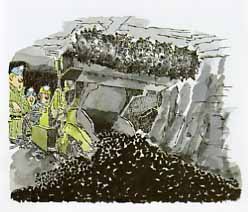


When we make steel, coal is as fully important a raw material as iron ore. This is because coke is made from coal and, as you'll see later, coke is the key that unlocks the iron trapped in iron ore. As a rule of thumb, a ton of coal is necessary for every ton of iron produced in a blast furnace.
J&L consumes nearly 7.7 million tons of metallurgical grade coal each year. This is coal that is suitable for conversion into coke. We produce about 7 million tons annually in our four partly owned and six wholly owned underground coal mines. These mines are located in Pennsylvania and West Virginia.
There are several underground coal mining techniques in use today.
The continuous mining machine (above) has a rotating drum that is studded with sharp cutting teeth. As the machine moves forward slowly, the teeth chew into the soft coal seam; chunks of coal fall to the floor beneath the cutting head and are retrieved by a conveyor system within the machine.
The loose coal is carried to the rear of the continuous miner and loaded into small electrically powered shuttle cars (not shown). Each car can carry about eight tons of coal. In turn, the shuttle cars bring the coal to a train of rail cars or to a long conveyor belt (above) that moves the coal to the surface.
Coals from different regions of the country have different volatilities: they contain varying amounts of oils, tars and other volatile substances that will be driven off as a gas when the coal is heated and made into coke. Some tend to form stronger coke than others. Low volatile coal expands when heated while high volatile coals contract.
The proper combination of expanding and contracting coals is necessary to make good strong coke.
J&L mixes 73 per cent high-volatile coal with 15 per cent mid-volatile and 12 percent low-volatile to produce the optimum blend for its coke ovens.
Incidentally, almost 80 percent of the coal
we use is transported to coke ovens at Pittsburgh and Aliquippa
in barges that travel the Mono ngahela and Ohio rivers. Coke ovens
at Indiana Harbor and Youngstown are supplied by rail.